Use of Instream Structure Technique for Aquatic Habitat Formation in Ecological Stream Restoration
Abstract
:1. Introduction
2. Methodology
2.1. Drought Flow
2.2. Low-Flow
2.3. Fish Flow and Instream Flow
2.4. Instream Structures
2.5. Numerical Modeling
3. Study Area
3.1. Variables of Hydraulic Dynamics
3.2. Determination of Drought Flow and Low-Flow
3.3. Determination of Target Aquatic Species and Fish Flow
3.4. Determination of the Instream Structure to Habitat Enhancement Design
4. Results and Discussion
4.1. Drought Flow and Low-Flow
4.1.1. Drought Flow
4.1.2. Hydrologically Based Flow Design
4.1.3. Biologically Based Flow Design
4.2. Fish Flow and Instream Flow
4.3. Detailed Design
4.3.1. Analysis of the Adequacy of the Stepping Stones Design Using Instream Flow Data
4.3.2. Analysis of the Adequacy of the Stepping Stone Design Using Monthly Time Series Data
5. Conclusions
Author Contributions
Funding
Acknowledgments
Conflicts of Interest
References
- Boolim Engineering. Master Plan of the Mokgamcheon Watershed; Boolim Engineering: Gwang Myeong City, Korea, 2002. [Google Scholar]
- Jowett, I.G. Instream flow methods: A comparison of approaches. Regul. Rivers Res. Manag. 1997, 13, 115–127. [Google Scholar] [CrossRef]
- Kunhwa Engineering. River Maintenance Master Plan for the Mokgamcheon; Kunhwa Engineering: Gyeonggi-do, Korea, 1995. [Google Scholar]
- Saman and Hankuk Engineering Consultants. Master Plan and Detailed Design of the Mokgamcheon Restoration; Saman and Hankuk Engineering Consultants: Gwang Myeong City, Korea, 2008. [Google Scholar]
- Pathak, N.; Girija, T.R.; Mahanta, C. Modeling application towards eco-restoration strategies for the polluted tributaries of the Brahmaputra River system. In Proceedings of the World Enivronmental and Water Resources Congress 2007: Restoring Our Natural Habitat, Tampa, FL, USA, 15–19 May 2007. [Google Scholar]
- Kondolf, G.M. Lessons learned from river restoration projects in California. Aquat. Conserv. Mar. Freshw. Ecosyst. 1998, 8, 39–52. [Google Scholar] [CrossRef]
- Palmer, M.A.; Benhardt, E.S.; Allan, J.D.; Lake, P.S.; Alexander, G.; Brooks, S.; Carr, J.; Clayton, S.; Dahm, C.N.; Follstad Shah, J.; et al. Standards for ecologically successful river restoration. J. Appl. Ecol. 2005, 42, 208–217. [Google Scholar] [CrossRef] [Green Version]
- Bovee, K.D. A Guide to Stream Habitat Analysis Using the Instream Flow Incremental Methodology; Instream Flow Information Paper 12; US Fish and Wildlife Service Biological Services Program, Cooperative Instream Flow Service Group: Fort Collins, CO, USA, 1982. [Google Scholar]
- Pretty, J.L.; Harrison, S.C.; Shepherd, D.J.; Smith, C.; Hildrew, A.G.; Hey, R.D. River rehabilitation and fish populations: Assessing the benefit of instream structures. J. Appl. Ecol. 2003, 40, 251–265. [Google Scholar] [CrossRef]
- Lee, K.S. Rehabilitation of the Hydrologic Cycle in the Anyangcheon Watershed, Sustainable Water Resources Research Center; Ministry of Education, Science and Technology: Seoul, Korea, 2007. [Google Scholar]
- Lee, K.S.; Chung, E.-S.; Kim, Y.O. Integrated watershed management for mitigating stream flow depletion in an urbanized watershed in Korea. Phys. Chem. Earth 2008, 33, 382–394. [Google Scholar] [CrossRef]
- Korea Water Resources Association. Criteria and Commentary of River Design; Korea Water Resources Association: Seoul, Korea, 2009. [Google Scholar]
- Lee, K.S.; Chung, E.S. Development of integrated watershed management schemes for an intensively urbanized region in Korea. J. Hydro-Environ. Res. 2007, 1, 95–109. [Google Scholar] [CrossRef]
- United States Environmental Protection Agency. Technical Guidance Manual for Performing Wasteload Allocations. Book VI: Design Conditions—Chapter 1: Stream Design Flow for Steady-State Modeling; US EPA: Washington, DC, USA, 1986.
- United States Environmental Protection Agency. DFLOW User’s Manual; Risk Reduction Engineering Laboratory Office of Research and Development: Washington, DC, USA, 1990.
- Ministry of Environment. Environmental Policy Act 21887; Ministry of Environment: Seoul, Korea, 2009.
- Gore, J.A.; Crawford, D.J.; Addison, D.S. An analysis of artificial riffles and enhancement of benthic community diversity by physical habitat simulation (PHABSIM) and direct observation. Regul. Rivers Res. Manag. 1998, 4, 69–77. [Google Scholar] [CrossRef]
- Maddock, I.P.; Bickerton, M.A.; Spence, R.; Pickering, T. Reallocation of compensation releases to restore river flows and improve instream habitat availability in the Upper Derwent catchment, Derbyshire, UK. Regul. Rivers Res. Manag. 2001, 17, 417–441. [Google Scholar] [CrossRef]
- Milhous, R.T.; Updike, M.A.; Schneider, D.M. Physical Habitat Simulation Reference Manual-Version II. Instream Flow Information Paper; US Fish and Wildlife Service: Fort Collins, CO, USA, 1989.
- Moir, H.J.; Gibbins, C.N.; Soulsby, C.; Youngson, A.F. PHABSIM modeling of Atlantic salmon spawning habitat in an upland stream: Testing the influence of habitat suitability indices on model output. River Res. Appl. 2005, 21, 1021–1034. [Google Scholar] [CrossRef]
- Shuler, S.W.; Nehring, R.B. Using the physical habitat simulation model to evaluate stream habitat enhancement project. Rivers 1993, 4, 175–193. [Google Scholar]
- United States Geological Survey. PHABSIM for Windows, User Manual and Exercises; Midcontinent Ecological Science Center, US Geological Survey: Washington, DC, USA, 2001.
- Lee, J.H.; Kil, J.T.; Jeong, S. Evaluation of physical fish habitat quality enhancement designs in urban streams using a 2D hydrodynamic model. Ecol. Eng. 2010, 36, 1251–1259. [Google Scholar] [CrossRef]
- Peter, S.; Julia, B. River2D: Introduction to Depth Averaged Modeling and User’s Manual; University of Alberta: Edmonton, AB, Canada, 2002. [Google Scholar]
- Rosgen, D.L. Watershed Assessment of River Stability and Sediment Supply (WARSSS); Wildland Hydrology: Fort Collins, CO, USA, 2006. [Google Scholar]
- Niezgoda, S.L.; Johnson, P.A. Modeling the long term impacts of using rigid structures in stream channel restoration. J. Am. Water Resour. Assoc. 2006, 42, 1597–1613. [Google Scholar] [CrossRef]
- Radspinner, R.R.; Diplas, P.; Lightbody, A.F.; Sotiropoulos, F. River training and ecological enhancement potential using instream structures. J. Hydraul. Eng. 2010, 136, 967–980. [Google Scholar] [CrossRef]
- Shields, F.D.; Cooper, C.M.; Knight, S.S. Experiment in stream restoration. J. Hydraul. Eng. 1995, 121, 494–502. [Google Scholar] [CrossRef]
- Kuhnle, R.A.; Alonso, C.V.; Shields, F.D. Geometry of scour holes associated with 90 degree spur dikes. J. Hydraul. Eng. 1999, 125, 972–978. [Google Scholar] [CrossRef]
- Kuhnle, R.A.; Alonso, C.V.; Shields, F.D. Local scour associated with angled spur dikes. J. Hydraul. Eng. 2002, 128, 1087–1093. [Google Scholar] [CrossRef]
- Rossman, L.A. Storm Water Management Model User’s Manual, Version 5.0; Water Supple and Water Resources Division National Risk Management Research Laboratory, United States Environmental Protection Agency: Cincinnati, OH, USA, 2010.
- United States Army Corps of Engineers. HEC-RAS River Analysis System User’s Manual, Version 4.1; CPD-68; U.S. Army Corps of Engineers Hydrologic Engineering Center: Davis, CA, USA, 2010. [Google Scholar]
- Hyundai Engineering. Integrated Flood Management in the Anyangcheon Basin, Ministry of Construction and Transportation; Seoul Regional Construction Management Administration: Seoul, Korea, 2005. [Google Scholar]
- Korea Institute of Construction Technology. Development and Application of Method to Determine Instream Flow Requirement; Korea Water Resources Corporation: Daejeon, Korea, 1995. [Google Scholar]
- Kim, K.H. Evaluation of Habitat Conditions and Estimation of Optimum Flow for the Freshwater Fish. Ph.D. Thesis, Yonsei University, Seoul, Korea, 1999. [Google Scholar]
- Nash, J.E.; Sutcliffe, J.V. River flow forecasting through conceptual model, part 1—A discussion of principles. J. Hydrol. 1970, 10, 282–290. [Google Scholar] [CrossRef]
- Water Resources Management Information System. Available online: http://www.wamis.go.kr (accessed on 15 May 2012).
- Kawanishi, R.; Dohi, R.; Fujii, A.; Inoue, M.; Miyake, Y. Vertical migration in streams: Seasonal use of the hyporheic zone by the spinous loach Cobitis shikokuensis. Ichthyol. Res. 2017, 64, 433–443. [Google Scholar] [CrossRef]
- Odum, W.E.; Odum, E.P.; Odum, H.T. Nature’s pulsing paradigm. Estuaries 1995, 18, 547–555. [Google Scholar] [CrossRef]
- Junk, W.J.; Bayley, P.B.; Sparks, R.E. The flood pulse concept in river-floodplain system. Can. J. Fish. Aquat. Sci. 1989, 106, 110–127. [Google Scholar]
- Sousa-Santos, C.; Robalo, J.I.; Francisco, S.M.; Carrapato, C.; Cardoso, A.C.; Doadrio, I. Metapopulations in temporary streams—The role of drought-flood cycles in promoting high genetic diversity in a critically endangered freshwater fish and its consequences for the future. Mol. Phylogenet. Evol. 2014, 80, 281–296. [Google Scholar] [CrossRef] [PubMed]
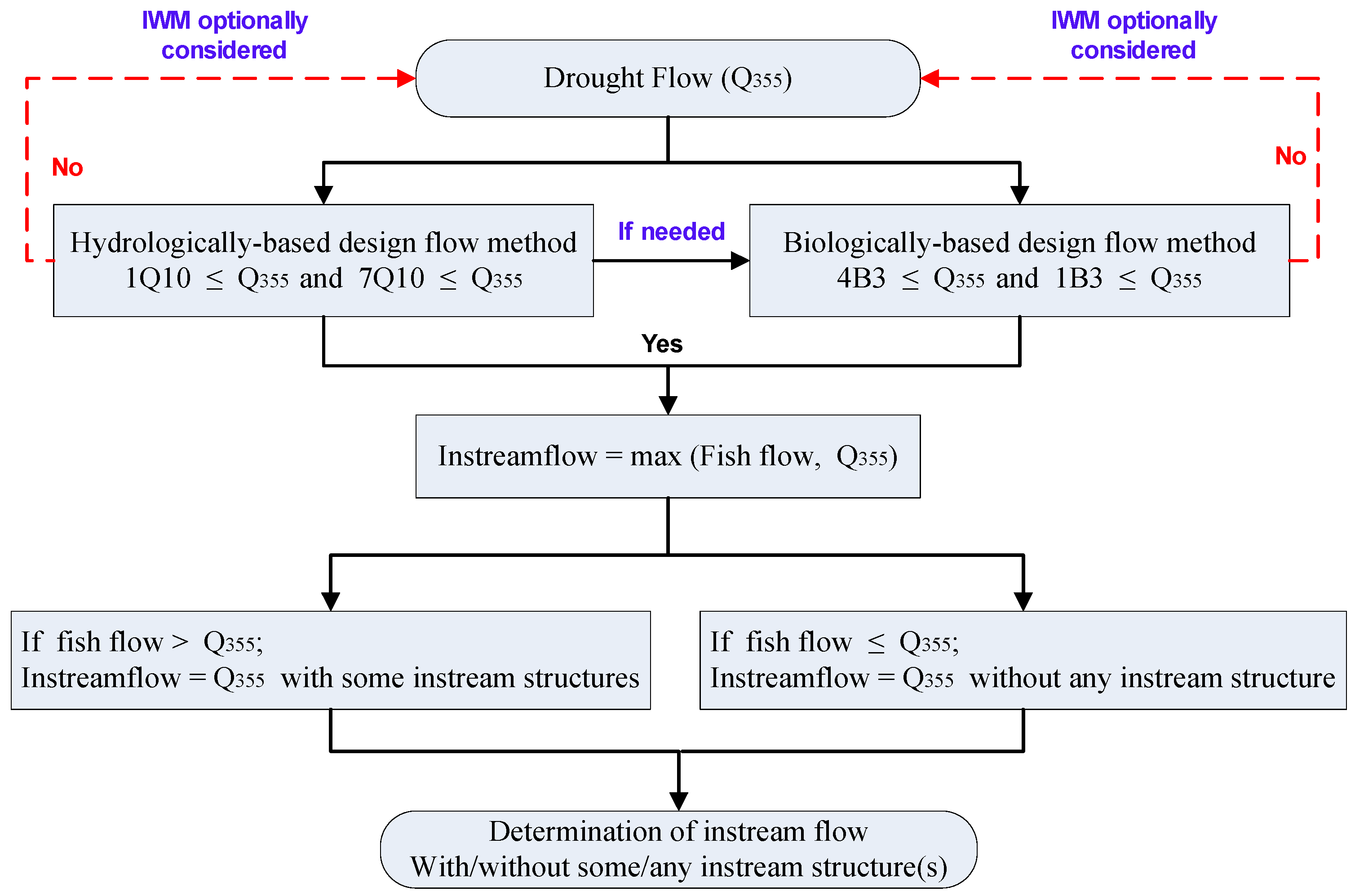

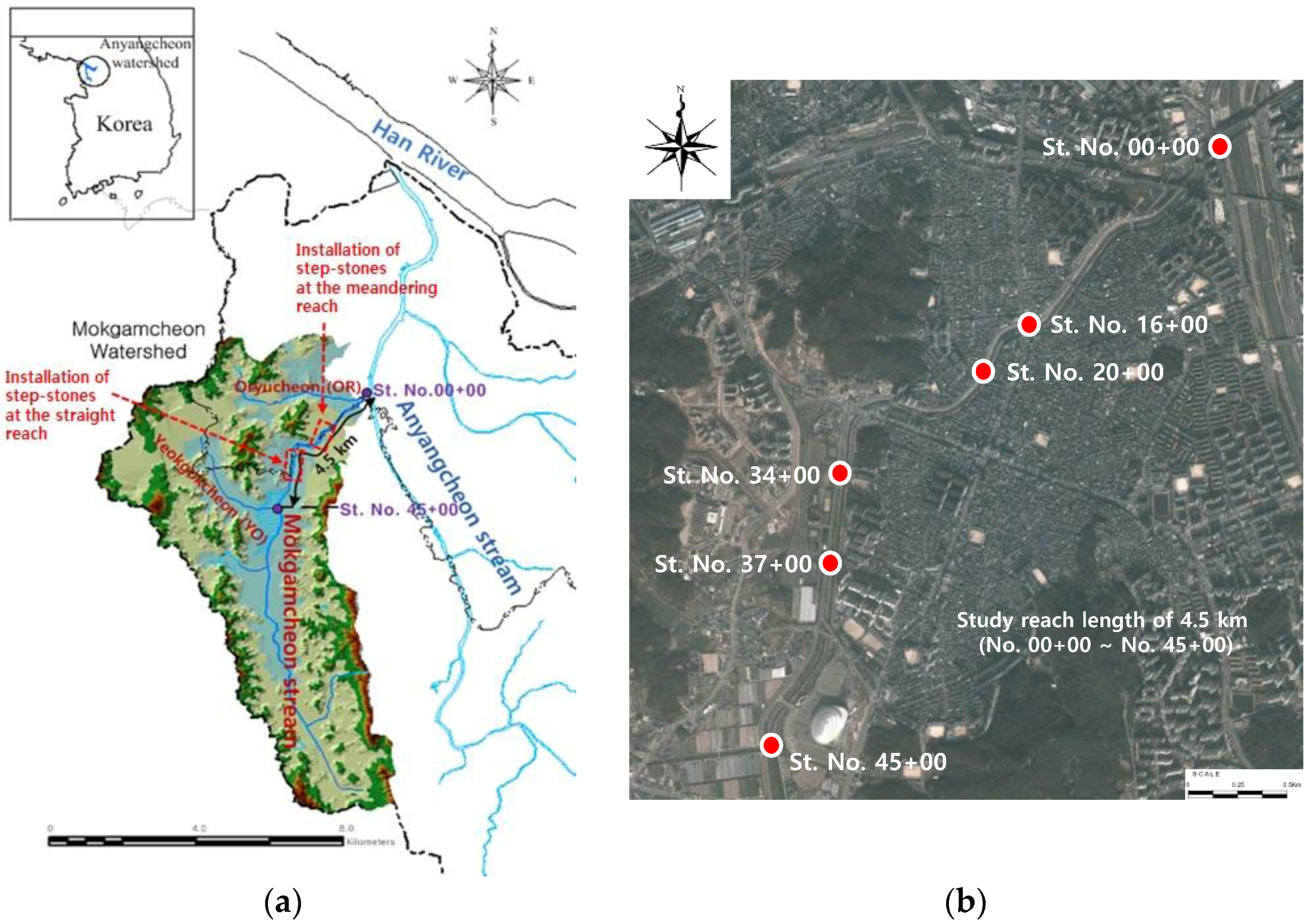
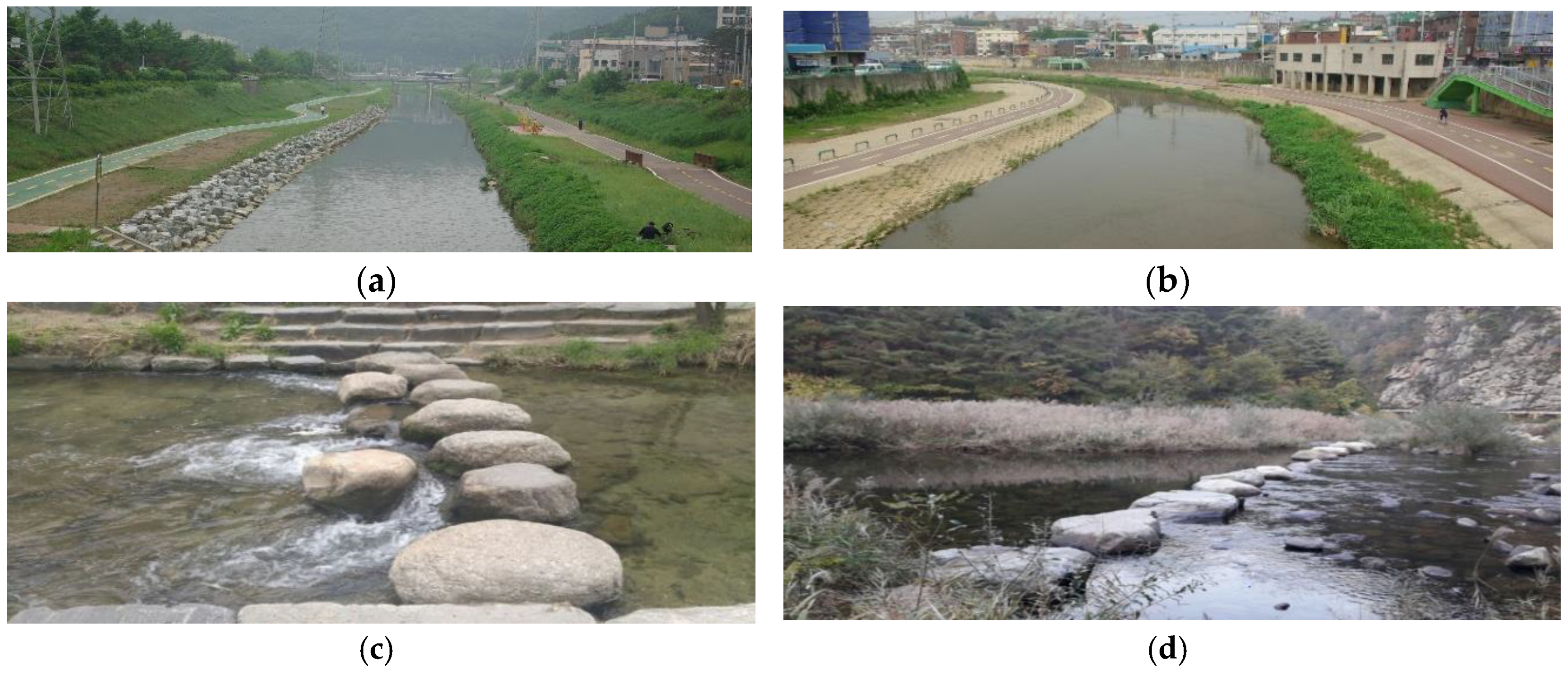



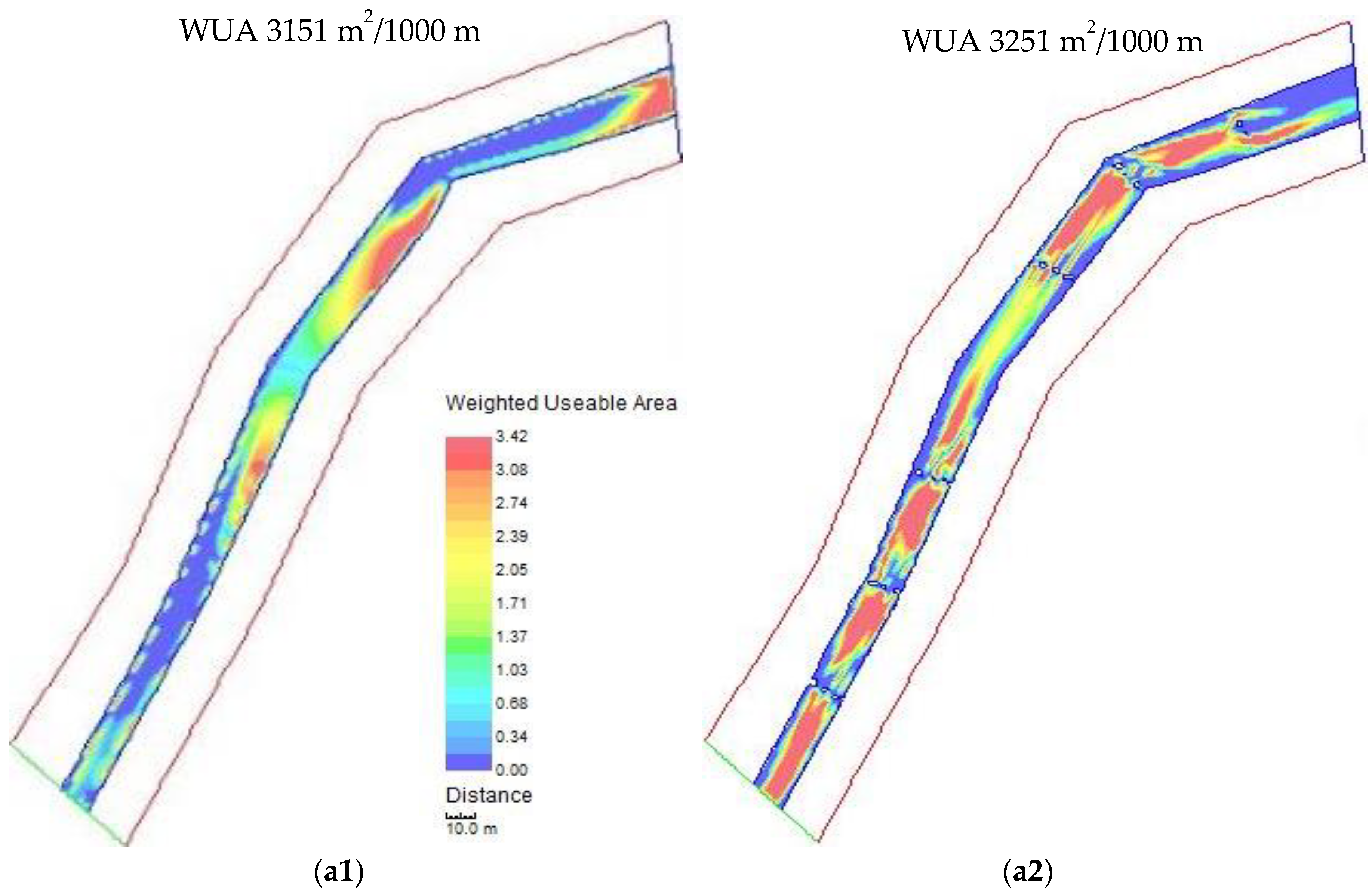

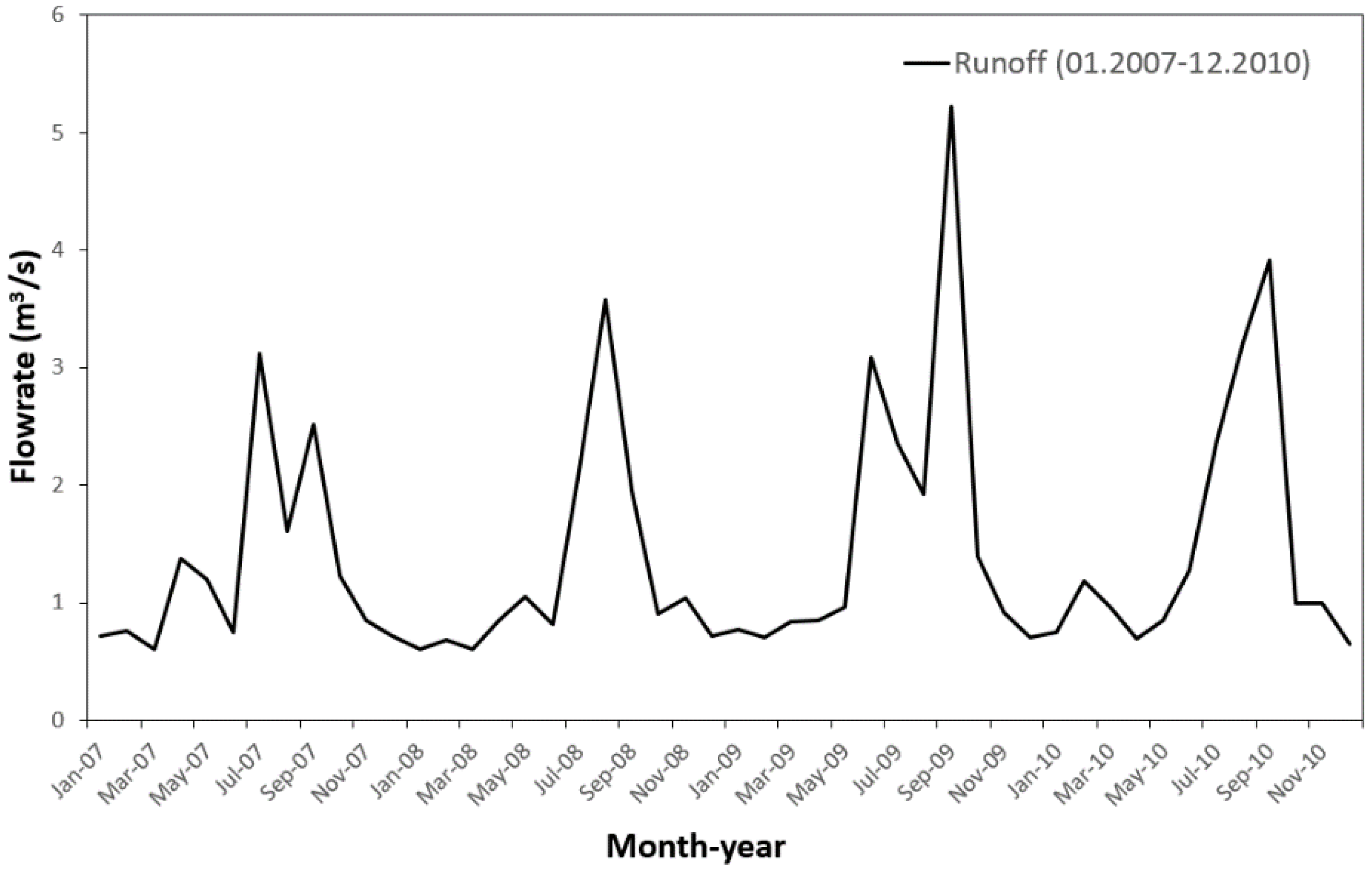


| Distance from the Anyangcheon Stream (m) | Station Number (No.) | Width of River (m) | Channel Width (m) | Bankfull Depth (m) | Bed Slope (m/m) | Median Particle Size, (mm) |
|---|---|---|---|---|---|---|
| 0–200 | 00+00–20+00 | 52.0 | 10.0 | 1.80 | 1/1670 | 0.89 |
| 200–400 | 20+00–40+00 | 48.0 | 30.5 | 1.50 | 1/909 | 0.61 |
| 400–600 | 40+00–60+00 | 30.0 | 13.5 | 2.07 | 1/556 | 8.44 |
| Category | Number of Data | Model Efficiency | RMSE | |
|---|---|---|---|---|
| Flow rate | Calibration | 26 | 0.908 | 1.325 m3/s |
| Verification | 22 | 0.632 | 0.612 m3/s |
| Category | Model | Number of Data | Correlation Coefficient, | |
|---|---|---|---|---|
| Water surface elevation | PHABSIM | Calibration | 26 | 0.9016 |
| Verification | 22 | 0.8024 | ||
| HEC-RAS | Calibration | 26 | 0.9513 | |
| Verification | 22 | 0.9241 |
| Period (Year) | Standard Drought Flow | Average Drought Flow | Probability Distribution of Drought Flow | Hydrological Low-Flow | ||
|---|---|---|---|---|---|---|
| 1964–2010 | 0.71 | 1.02 | LP3 | 1Q10 (CMC) | 7Q10 (CCC) | Probability distribution |
| 0.69 | 0.72 | LP3 | ||||
| Cluster Periods | Excursion Periods | ||
|---|---|---|---|
| Start Day | Number of Excursions | Start Day | Duration (Days) |
| 27 June 1965 | 2 | 27 June 1965 | 2 |
| 4 April 1977 | 5 | 4 April 1977 | 10 |
| 24 March 1988 | 2 | 24 March 1988 | 1 |
| 3 May 1988 | 1 | ||
| 20 April 2000 | 5 | 20 April 2000 | 2 |
| 23 April 2000 | 12 | ||
| 13 May 2000 | 1 | ||
| Total | 14 | ||
| Low-flow for 1B3 (CMC) | 0.63 | ||
| Cluster Periods | Excursion Periods | ||
|---|---|---|---|
| Start Day | Number of Excursions | Start Day | Duration (Days) |
| 24 June 1965 | 1.25 | 24 June 1965 | 5 |
| 30 March 1977 | 4 | 30 March 1977 | 16 |
| 20 March 1988 | 4 | 20 March 1988 | 10 |
| 28 April 1988 | 6 | ||
| 23 March 1999 | 1.5 | 23 March 1999 | 6 |
| 13 April 2000 | 5 | 13 April 2000 | 31 |
| Total | 15.25 | ||
| Low-flow for 4B3 (CCC) | 0.71 | ||
| Target Species | Water Depth | Velocity | ||||
|---|---|---|---|---|---|---|
| Spawning | Fry | Adult | Spawning | Fry | Adult | |
| Carassius auratus | 0.2–0.5 (May, June) | 0.1–0.4 (Summer–Fall) | 0.3–2.0 (Spring–Fall) | 0.05–0.1 | 0.1–0.2 | 0.2–0.3 |
| Zacco platypus | 0.1–0.3 (April, May) | 0.1–0.4 (Summer–Fall) | 0.1–0.7 (Spring–Fall) | 0.1–0.3 | 0.1–0.4 | 0.2–0.6 |
| Target Species | Spawning | Fry | Adult | |||
|---|---|---|---|---|---|---|
| Discharge | Maximum Weighted Usable Area | Discharge | Maximum Weighted Usable Area | Discharge | Maximum Weighted Usable Area | |
| Carassius auratus | 0.25 | 4399 | 0.45 | 5718 | 0.80 | 4868 |
| Zacco platypus | 0.65 | 6346 | 0.65 | 6936 | 0.70 | 8287 |
| Target Species | Standard Drought Flow | Fish Flow | ||||||
|---|---|---|---|---|---|---|---|---|
| April | May | June | July | August | September | October | ||
| Carassius auratus | 0.71 | 0.80 | 0.25 | 0.25 | 0.45 | 0.45 | 0.80 | 0.80 |
| Zacco platypus | 0.71 | 0.65 | 0.65 | 0.65 | 0.65 | 0.65 | 0.70 | 0.70 |
| Target Species | Month | |||||||||||
|---|---|---|---|---|---|---|---|---|---|---|---|---|
| January | February | March | April | May | June | July | August | September | October | November | December | |
| Carassius auratus | 0.71 | 0.71 | 0.71 | 0.80 | 0.71 | 0.71 | 0.71 | 0.71 | 0.80 | 0.80 | 0.71 | 0.71 |
| Zacco platypus | 0.71 | 0.71 | 0.71 | 0.71 | 0.71 | 0.71 | 0.71 | 0.71 | 0.71 | 0.71 | 0.71 | 0.71 |
| Observation Point | Straight Channel Reach (No. 37+00–No. 34+00) | Meandering Channel Reach (No. 20+00–No. 16+00) | ||||||
|---|---|---|---|---|---|---|---|---|
| Without Any Instream Structure | With Stepping Stones | Without Any Instream Structure | With Stepping Stones | |||||
| A1 | 0.045 | 0.349 | 0.098 | 0.964 | 0.087 | 0.411 | 0.018 | 0.108 |
| A2 | 0.049 | 0.385 | 0.095 | 1.097 | 0.063 | 0.395 | 0.080 | 0.509 |
| A3 | 0.032 | 0.313 | 0.074 | 0.947 | 0.065 | 0.353 | 0.082 | 0.494 |
| B1 | 0.068 | 0.369 | 0.098 | 0.920 | 0.047 | 0.240 | 0.073 | 0.343 |
| B2 | 0.045 | 0.227 | 0.031 | 0.355 | 0.065 | 0.394 | 0.084 | 0.488 |
| B3 | 0.045 | 0.239 | 0.084 | 0.813 | 0.044 | 0.187 | 0.105 | 1.070 |
| B4 | 0.051 | 0.259 | 0.032 | 0.363 | 0.029 | 0.096 | 0.016 | 0.074 |
| B5 | 0.061 | 0.336 | 0.089 | 0.895 | 0.021 | 0.141 | 0.063 | 0.305 |
| B6 | - | - | - | - | 0.082 | 0.511 | 0.096 | 0.954 |
| B7 | - | - | - | - | 0.074 | 0.451 | 0.068 | 0.315 |
| Reach | Instream Structure | Target Fish | WUA | ||
|---|---|---|---|---|---|
| Spawning | Fry | Adult | |||
| No. 37+00–No. 34+00 Straight channel reach | Without any instream structure | Zacco platypus | 1963 | 1908 | 2962 |
| Carassius auratus | 368 | 663 | 769 | ||
| Stepping stones | Zacco platypus | 1968 | 3038 | 3468 | |
| Carassius auratus | 264 | 1057 | 2394 | ||
| No. 20+00–No. 16+00 Meandering channel reach | Without any instream structure | Zacco platypus | 1424 | 2396 | 3771 |
| Carassius auratus | 1233 | 2164 | 3151 | ||
| Stepping stones | Zacco platypus | 1984 | 3430 | 4508 | |
| Carassius auratus | 1697 | 1934 | 3251 | ||
| Reach | Instream Structure | Target Fish | WUA | |
|---|---|---|---|---|
| Fry | Adult | |||
| No. 37+00–No. 34+00 Straight channel reach | Without any instream structure | Zacco platypus | 154 | 839 |
| Carassius auratus | 260 | 386 | ||
| Stepping stones | Zacco platypus | 218 | 603 | |
| Carassius auratus | 153 | 216 | ||
© 2018 by the authors. Licensee MDPI, Basel, Switzerland. This article is an open access article distributed under the terms and conditions of the Creative Commons Attribution (CC BY) license (http://creativecommons.org/licenses/by/4.0/).
Share and Cite
Park, K.; Lee, K.S.; Kim, Y.-O. Use of Instream Structure Technique for Aquatic Habitat Formation in Ecological Stream Restoration. Sustainability 2018, 10, 4032. https://doi.org/10.3390/su10114032
Park K, Lee KS, Kim Y-O. Use of Instream Structure Technique for Aquatic Habitat Formation in Ecological Stream Restoration. Sustainability. 2018; 10(11):4032. https://doi.org/10.3390/su10114032
Chicago/Turabian StylePark, Kidoo, Kil Seong Lee, and Young-Oh Kim. 2018. "Use of Instream Structure Technique for Aquatic Habitat Formation in Ecological Stream Restoration" Sustainability 10, no. 11: 4032. https://doi.org/10.3390/su10114032




